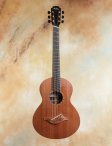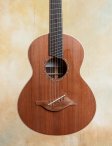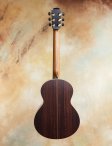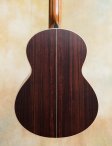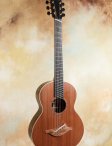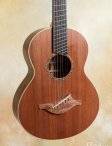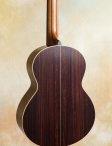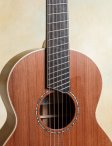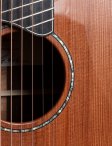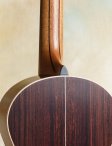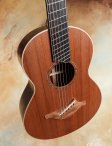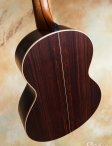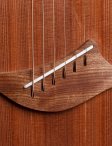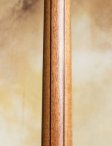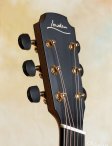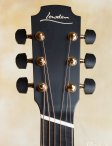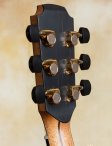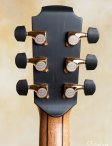Wee Lowden - Fan Fret
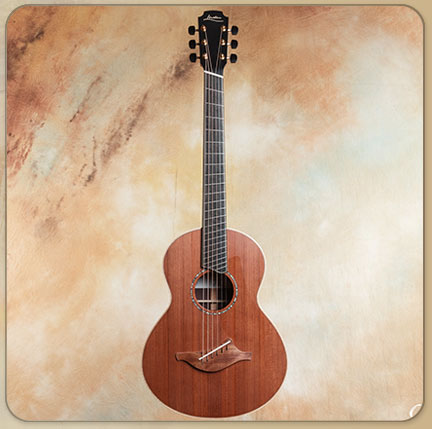
Price: $--SOLD
inquire - info@crguitars.com
call us -
hardshell case included
A new Wee Lowden just arrived with the surprisingly cool addition of what is often termed fanned frets. It would be more descriptive to call it a multi-scale guitar, however. The ever curious and forward thinking George Lowden realized that the multi-scale approach could further extend and open the low end of the smallest guitar he makes.
A new Wee Lowden just arrived with the surprisingly cool addition of what is often termed fanned frets. It would be more descriptive to call it a multi-scale guitar, however. Multi-scale fretted instruments have been around for hundreds of years, but in 1989 California luthier Ralph Novak received a patent for his guitar design. The patent has expired at this point—though he still retains the trademark for the term "fanned fret" and many makers have been exploring multi-scale guitars in the last 10 or so years. It is often thought that such guitars intonate and tune better than standard scale guitars, but in my experience there really isn’t a noticeable difference, and the best reason to have a multi-scale guitar has to do with tone.
You often see fanned frets on larger bodied guitars, particularly baritone guitars, where the luthiers have created an instrument with great bass response and want to reign in the treble response. But the ever curious and forward thinking George Lowden realized that the multi-scale approach could further extend and open the low end of the smallest guitar he makes. In fact, fanned frets work very well with any instrument that has strings of varying thicknesses. You’ll get the concept if you picture the insides of a piano, with the thinnest strings being the shortest in length and the thickest strings the longest, allowing each to vibrate more naturally in their own frequency range.
If you haven’t played a fan fret guitar before, rest assured its actually quite easy to get a feel for one. In fact if you play at first without looking at your hands, your fingers will find the notes and chords more effortlessly than you expect, and you may notice less tension in your fretting hand because the design allows for a more natural hand position. It does take a little getting used to when you first start to look at your fretting hand, but in no time you’ll discover that playing a fan fret guitar is not only easy, but you’ll quickly learn to love the full and balanced tone.
Despite being the smallest guitar in the Lowden oeuvre, this Wee has surprising projection. The 650 mm scale of the lowest string extends the richness of the bass frequencies, while the 610 mm scale of the top string makes the trebles sing out with bell-like clarity. The carefully chosen scale lengths allow for the tonal benefits while also keeping good ergonomics for ease of playing. The guitar is fantastic in standard tuning, and if you play in dropped D, DADGAD or other lower tunings, the difference from a standard scale guitar is unexpected. It won’t make the Wee Lowden sound like a jumbo, but the difference is definitely noticeable. I’d say that the fan fret Wee Lowden is perhaps more pianistic than the regular scale model.
There is a refinement to the Lowden sound that only comes from a master, a luthier who has spent years and years in the trenches honing skills to mastery and finally into true art (George Lowden has been making guitars for more than 40 years). The development of this guitar began nearly three years ago when Gary Lightbody (of the band Snow Patrol) contacted Lowden about building a guitar as a gift for Ed Sheeran, but George had been thinking about a small bodied guitar for years. For such a design, it was never a matter of simply shrinking one of his other models, and Lightbody’s request proved the impetus for him to develop a small bodied instrument.
To that end George sequestered himself alone on the coast of Northern Ireland to draw the shape and develop the design concepts uninterrupted. He knew from the start that he wanted to evolve the design to sound big and three dimensional (not boxy as small guitars often do), but he also wanted the articulate and present quality of a smaller guitar. He was wrestling with physics as he worked the ideas, but all the elements came together, and with careful selection of materials, the Wee really lives up to the Lowden name.
The top is redwood, with Lowden’s unique top bracing technique (known as dolphin bracing) giving it a fast and articulate responsiveness, with premium Indian rosewood back and sides. Indian rosewood is at least equal to Brazilian when the best grades are used, and the advantage with Indian is that it is more readily available so a guitarmaker can use the best-of-the-best grade, whereas with Brazilian, premium quality is almost impossible to find. Moreover, George Lowden has been using Indian rosewood for many years and deeply understands its character. The traditional Lowden five piece mahogany and rosewood neck is a perfect C shape that feels just right in the hand.
Easy to carry, wonderful to play, with a huge and fantastically balanced sound that belies its small size, and with the especially cool and eminently useful multi-scale frets, this is a true player’s guitar that will be a marvelous partner for making music on stage, in your living room, or anywhere else you play guitar.
If you'd like to find out more about this item, just call or e-mail me. It would be my pleasure to talk to you about it.
ABOUT LOWDEN GUITARS
Lowden guitars occupy a unique place in the pantheon of high-end flattops. With a loud and overtone-rich signature voice, unique construction details (including a split saddle and A-frame bracing of the upper bout), and a general vibe that differs from most classic American steel-strings, the guitars have found fans in such heavyweights as Pierre Bensusan, Paul Brady, Alex de Grassi, Richard Thompson, and many others. Lowden production began in 1974, and after several changes in management and manufacturing facilities, the guitars are now built in a small Northern Ireland shop under the direct supervision of company founder George Lowden.
| Back & sides | premium Indian rosewood |
| Top | redwood |
| Neck | 5 piece mahogany/rosewood |
| Fingerboard | ebony |
| Bridge | premium Indian rosewood |
| Rosette | rosewood, sycamore, mahogany |
| Binding | figured mahogany |
| Headstock veneer | ebony |
| Finish | hand rubbed |
| Tuners | Schaller M6 gold with ebony buttons |
| Nut | bone |
| Saddle | bone |
| Scale | 610 mm treble side, 650 mm bass side |
| Case | Lowden custom Hiscox |

